Integrate Amazon Business with Microsoft Entra ID
In this article, you learn how to integrate Amazon Business with Microsoft Entra ID. When you integrate Amazon Business with Microsoft Entra ID, you can:
- Control in Microsoft Entra ID who has access to Amazon Business.
- Enable your users to be automatically signed-in to Amazon Business with their Microsoft Entra accounts.
- Manage your accounts in one central location.
Prerequisites
To get started, you need the following items:
- A Microsoft Entra subscription. If you don't have a subscription, you can get a free account.
- An Amazon Business single sign-on (SSO) enabled subscription. Go to the Amazon Business page to create an Amazon Business account.
Scenario description
In this article, you configure and test Microsoft Entra SSO in an existing Amazon Business account.
- Amazon Business supports SP and IDP initiated SSO.
- Amazon Business supports Just In Time user provisioning.
- Amazon Business supports Automated user provisioning.
Note
Identifier of this application is a fixed string value so only one instance can be configured in one tenant.
Add Amazon Business from the gallery
To configure the integration of Amazon Business into Microsoft Entra ID, you need to add Amazon Business from the gallery to your list of managed SaaS apps.
- Sign in to the Microsoft Entra admin center as at least a Cloud Application Administrator.
- Browse to Identity > Applications > Enterprise applications > New application.
- In the Add from the gallery section, type Amazon Business in the search box.
- Select Amazon Business from results panel and then add the app. Wait a few seconds while the app is added to your tenant.
Alternatively, you can also use the Enterprise App Configuration Wizard. In this wizard, you can add an application to your tenant, add users/groups to the app, assign roles, and walk through the SSO configuration as well. Learn more about Microsoft 365 wizards.
Configure and test Microsoft Entra SSO for Amazon Business
Configure and test Microsoft Entra SSO with Amazon Business using a test user called B.Simon. For SSO to work, you need to establish a link relationship between a Microsoft Entra user and the related user in Amazon Business.
To configure and test Microsoft Entra SSO with Amazon Business, perform the following steps:
- Configure Microsoft Entra SSO - to enable your users to use this feature.
- Create a Microsoft Entra test user - to test Microsoft Entra single sign-on with B.Simon.
- Assign the Microsoft Entra test user - to enable B.Simon to use Microsoft Entra single sign-on.
- Configure Amazon Business SSO - to configure the single sign-on settings on application side.
- Create Amazon Business test user - to have a counterpart of B.Simon in Amazon Business that is linked to the Microsoft Entra representation of user.
- Test SSO - to verify whether the configuration works.
Configure Microsoft Entra SSO
Follow these steps to enable Microsoft Entra SSO.
Sign in to the Microsoft Entra admin center as at least a Cloud Application Administrator.
Browse to Identity > Applications > Enterprise applications > Amazon Business application integration page, find the Manage section and select Single sign-on.
On the Select a Single sign-on method page, select SAML.
On the Set up Single Sign-On with SAML page, select the pencil icon for Basic SAML Configuration to edit the settings.

On the Basic SAML Configuration section, if you wish to configure in IDP initiated mode, perform the following steps:
In the Identifier (Entity ID) text box, type one of the following URLs:
URL Region https://www.amazon.comNorth America https://www.amazon.co.jpEast Asia https://www.amazon.deEurope In the Reply URL text box, type a URL using one of the following patterns:
URL Region https://www.amazon.com/bb/feature/sso/action/3p_redirect?idpid={idpid}North America https://www.amazon.co.jp/bb/feature/sso/action/3p_redirect?idpid={idpid}East Asia https://www.amazon.de/bb/feature/sso/action/3p_redirect?idpid={idpid}Europe Note
The Reply URL value is not real. Update this value with the actual Reply URL. You will get the
<idpid>value from the Amazon Business SSO configuration section, which is explained later in the article. You can also refer to the patterns shown in the Basic SAML Configuration section.
If you want to configure the application in SP initiated mode, you need to add the full URL provided in the Amazon Business configuration to the Sign-on URL in the Set additional URLs section.
The following screenshot shows the list of default attributes. Edit the attributes by clicking on the pencil icon in the User Attributes & Claims section.

Edit Attributes and copy Namespace value of these attributes into the Notepad.
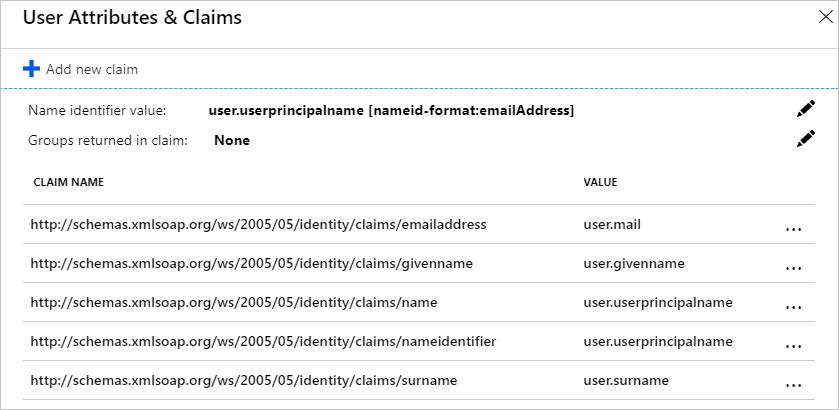
In addition to above, Amazon Business application expects few more attributes to be passed back in SAML response. In the User Attributes & Claims section on the Group Claims dialog, perform the following steps:
Select the pen next to Groups returned in claim.

In the Group Claims dialog, select All Groups from the radio list.
Select Group ID as Source attribute.
Check Customize the name of the group claim checkbox and enter the group name according to your Organization requirement.
Select Save.
On the Set up single sign-on with SAML page, In the SAML Signing Certificate section, select copy button to copy App Federation Metadata Url and save it on your computer.

On the Set up Amazon Business section, copy the appropriate URLs based on your requirement.

Create a Microsoft Entra test user
In this section, you create a test user called B.Simon.
Note
Administrators need to create the test users in their tenant if needed. Following steps show how to create a test user.
- Sign in to the Microsoft Entra admin center as at least a User Administrator.
- Browse to Identity > Users > All users.
- Select New user > Create new user, at the top of the screen.
- In the User properties, follow these steps:
- In the Display name field, enter
B.Simon. - In the User principal name field, enter the username@companydomain.extension. For example,
B.Simon@contoso.com. - Select the Show password check box, and then write down the value that's displayed in the Password box.
- Select Review + create.
- In the Display name field, enter
- Select Create.
Create a Microsoft Entra Security Group in the Azure portal
Browse to Identity > Groups > All Groups.
Select New group:

Fill in Group type, Group name, Group description, Membership type. Select on the arrow to select members, then search for or select on the member you like to add to the group. Select on Select to add the selected members, then select on Create.
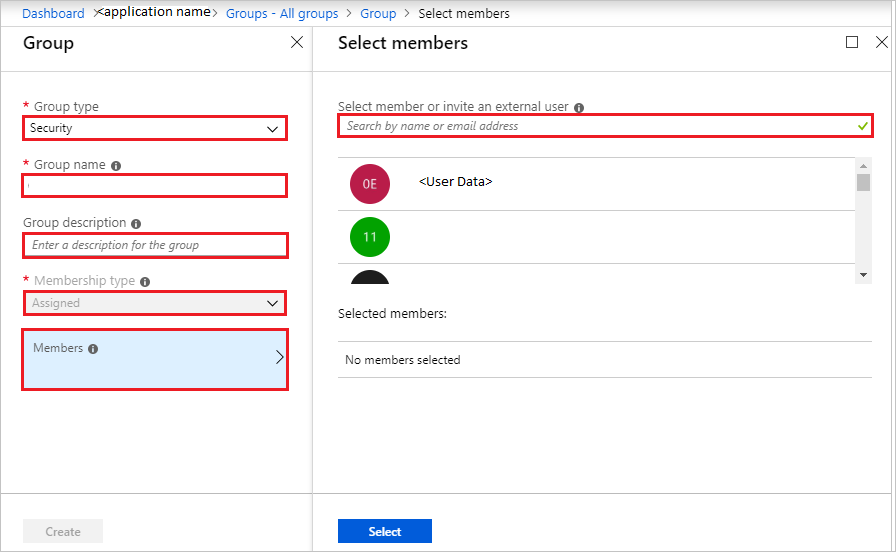
Assign the Microsoft Entra test user
In this section, you enable B.Simon to use single sign-on by granting access to Amazon Business.
Sign in to the Microsoft Entra admin center as at least a Cloud Application Administrator.
Browse to Identity > Applications > Enterprise applications > Amazon Business.
In the app's overview page, find the Manage section and select Users and groups.
Select Add user, then select Users and groups in the Added Assignment dialog.
In the Users and groups dialog, select B.Simon from the Users list, then select the Select button at the bottom of the screen.
If you're expecting any role value in the SAML assertion, in the Select Role dialog, select the appropriate role for the user from the list and then select the Select button at the bottom of the screen.
In the Added Assignment dialog, select the Assign button.
Note
If you do not assign the users in the Microsoft Entra ID, you get the following error.
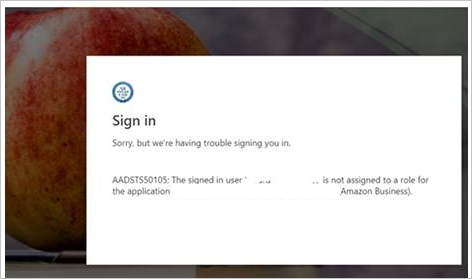
Assign the Microsoft Entra Security Group in the Azure portal
Sign in to the Microsoft Entra admin center as at least a Cloud Application Administrator.
Browse to Identity > Applications > Enterprise applications > Amazon Business.
In the applications list, type and select Amazon Business.
In the menu on the left, select Users and groups.
Select the Added user.
Search for the Security Group you want to use, then select on the group to add it to the Select members section. Select Select, then select Assign.

Note
Check the notifications in the menu bar to be notified that the Group was successfully assigned to the Enterprise application.
Configure Amazon Business SSO
In a different web browser window, sign in to your up Amazon Business company site as an administrator
Select on the User Profile and select Business Settings.

On the System integrations wizard, select Single Sign-On (SSO).

On the Set up SSO wizard, select the provider according to your Organizational requirements and select Next.
Note
Although Microsoft ADFS is a listed option, it won't work with Microsoft Entra SSO.
On the New user account defaults wizard, select the Default Group and then select Default Buying Role according to user role in your Organization and select Next.

On the Upload your metadata file wizard, choose Paste XML Link option to paste the App Federation Metadata URL value, and select Validate.
Note
Alternatively, you can also upload the Federation Metadata XML file by clicking on the Upload XML File option.
After uploading the downloaded metadata file, the fields in the Connection data section will populate automatically. After that select Next.
On the Upload your Attribute statement wizard, select Skip.

On the Attribute mapping wizard, add the requirement fields by clicking the + Add a field option. Add the attribute values including the namespace, which you have copied from the User Attributes & Claims section of Azure portal into the SAML AttributeName field, and select Next.
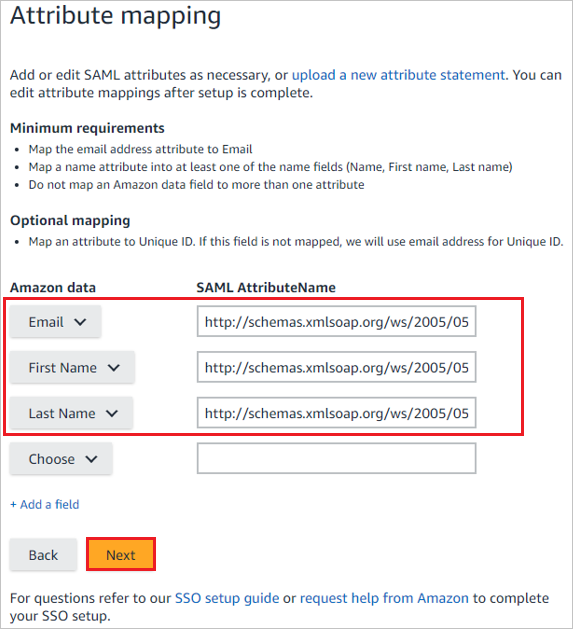
On the Amazon connection data wizard, please confirm your IDP has configured and select Continue.

Check the Status of the steps that have been configured and select Start testing.
On the Test SSO Connection wizard, select Test.

On the IDP initiated URL wizard, before you select Activate, copy the value, which is assigned to idpid and paste into the idpid parameter in the Reply URL in the Basic SAML Configuration section.

On the Are you ready to switch to active SSO? wizard, check I have fully tested SSO and am ready to go live checkbox and select on Switch to active.
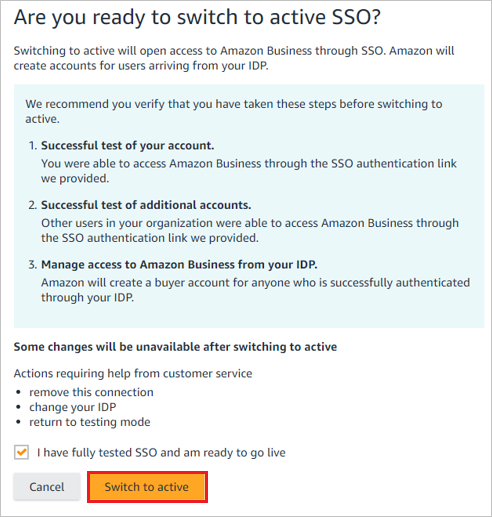
Finally in the SSO Connection Details section the Status is shown as Active.
Note
If you want to configure the application in SP initiated mode, complete the following step, paste the sign-on URL from the screenshot above in the Sign-on URL text box of the Set additional URLs section. Use the following format:
https://www.amazon.<TLD>/bb/feature/sso/action/start?domain_hint=<UNIQUE_ID>
Create Amazon Business test user
In this section, a user called B.Simon is created in Amazon Business. Amazon Business supports just-in-time user provisioning, which is enabled by default. There's no action item for you in this section. If a user doesn't already exist in Amazon Business, a new one is created after authentication.
Test SSO
In this section, you test your Microsoft Entra single sign-on configuration with following options.
SP initiated:
Select on Test this application, this will redirect to Amazon Business Sign-on URL where you can initiate the sign-in flow.
Go to the Amazon Business Single Sign-on URL directly and initiate the sign-in flow from there.
IDP initiated:
- Select on Test this application, and you should be automatically signed in to the Amazon Business for which you set up the SSO.
You can also use Microsoft My Apps to test the application in any mode. When you select the Amazon Business tile in the My Apps, if configured in SP mode you would be redirected to the application sign-on page for initiating the sign-in flow and if configured in IDP mode, you should be automatically signed in to the Amazon Business for which you set up the SSO. For more information about the My Apps, see Introduction to the My Apps.
Reconfiguring Service Provider Settings from ADFS to Microsoft Entra ID
Prepare Microsoft Entra ID Environment
- Verify Microsoft Entra ID Premium Subscription Ensure you have a Microsoft Entra ID Premium subscription, which is required for single sign-on (SSO) and other advanced features.
Register the Application in Microsoft Entra ID
- Navigate to Microsoft Entra ID in the Azure portal.
- Select "App registrations" > "New registration".
- Fill in the required details:
- Name: Enter a meaningful name for the application.
- Supported account types: Choose the appropriate option for your environment.
- Redirect URI: Enter the necessary redirect URIs (usually your application’s sign-in URL).
Configure Microsoft Entra ID SSO
- Set Up single sign-on in Microsoft Entra ID.
- In the Azure portal, go to Microsoft Entra ID > Enterprise applications.
- Select your application from the list.
- Under "Manage", select "Single sign-on".
- Choose "SAML" as the Single Sign-On method.
- Edit the Basic SAML Configuration:
- Identifier (Entity ID): Enter the SP Entity ID.
- Reply URL (Assertion Consumer Service URL): Enter the SP ACS URL.
- Sign on URL: Enter the application sign-on URL if applicable.
Configure User Attributes & Claims
- In the SAML-based Sign-On settings, select "User Attributes & Claims".
- Edit and configure claims to match those required by your SP. Typically, this includes:
- NameIdentifier
- GivenName
- Surname
- etc.
Download Microsoft Entra ID SSO Metadata
In the SAML Signing Certificate section, download the Federation Metadata XML. This is used to configure your SP.
Reconfigure Service Provider (SP)
- Update SP to Use Microsoft Entra ID Metadata
- Access your SP’s configuration settings.
- Update the IdP metadata URL or upload the Microsoft Entra ID Metadata XML.
- Update the Assertion Consumer Service (ACS) URL, Entity ID, and any other required fields to match the Microsoft Entra ID configuration.
Configure SAML Certificates
Ensure that the SP is configured to trust the signing certificate from Microsoft Entra ID. This can be found in the SAML Signing Certificate section of the Microsoft Entra ID SSO configuration.
Test SSO Configuration
Initiate a test login from the SP.
Verify that the authentication redirects to Microsoft Entra ID and successfully logs in the user.
Check the claims being passed to ensure they match what the SP expects.
Update DNS and Network Settings (If Applicable). If your SP or application uses DNS settings specific to ADFS, you might need to update these settings to point to Microsoft Entra ID endpoints.
Roll out and Monitor
- Communicate with Users Notify your users of the change and provide any necessary instructions or documentation.
- Monitor Authentication Logs Keep an eye on the Microsoft Entra ID sign-in logs to monitor for any authentication issues and address them promptly.
Related content
Once you configure Amazon Business you can enforce session control, which protects exfiltration and infiltration of your organization’s sensitive data in real time. Session control extends from Conditional Access. Learn how to enforce session control with Microsoft Defender for Cloud Apps.